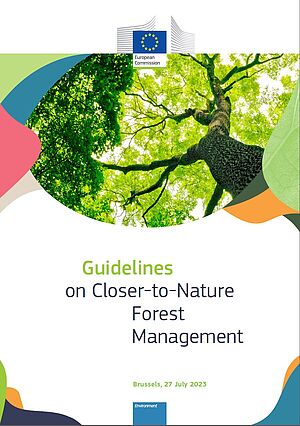
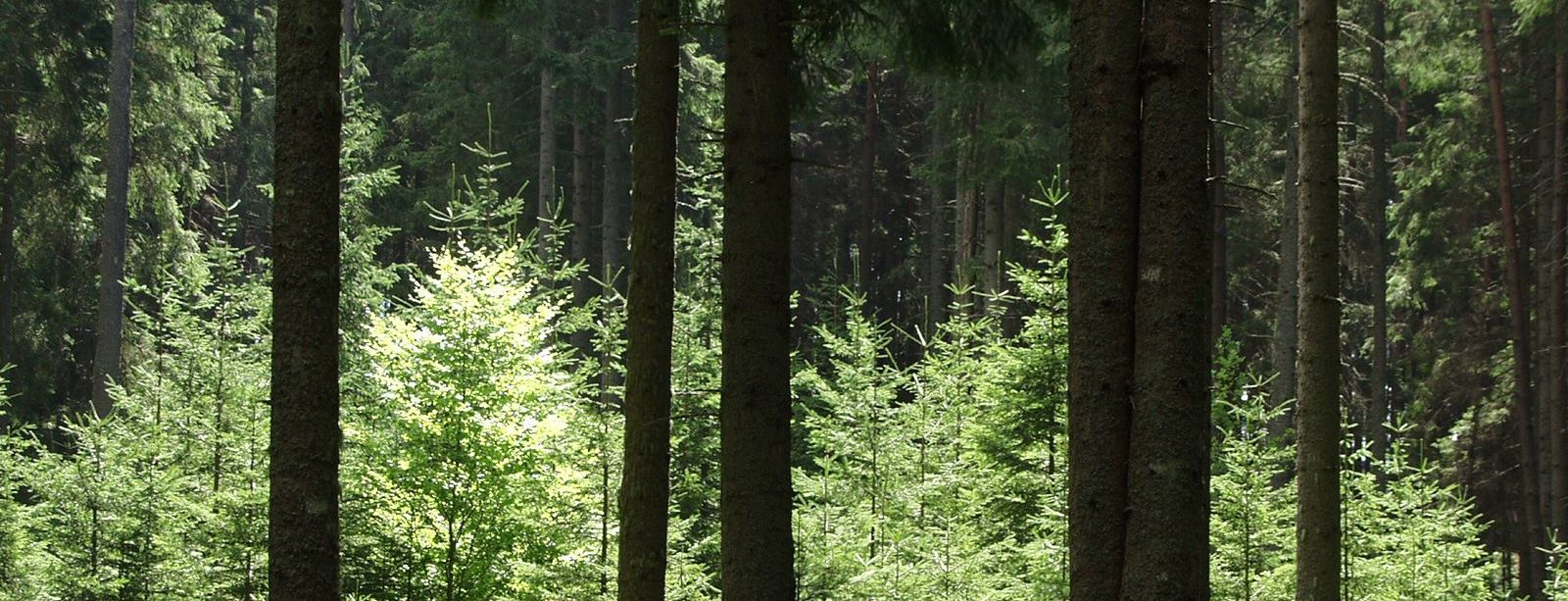


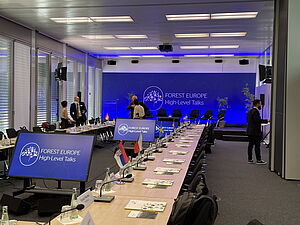
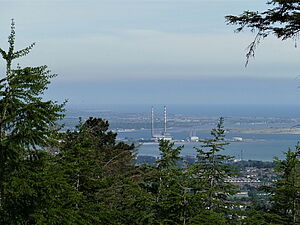
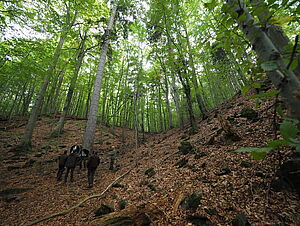
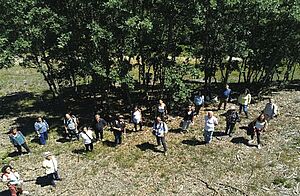
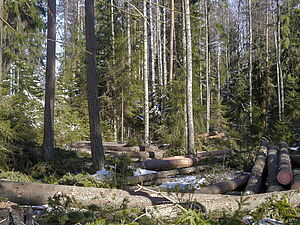
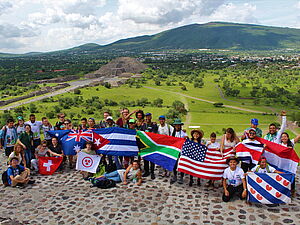
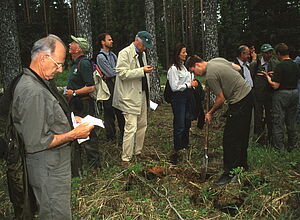
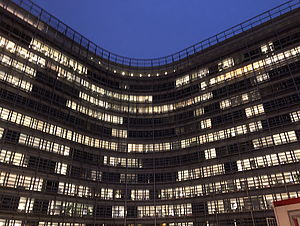
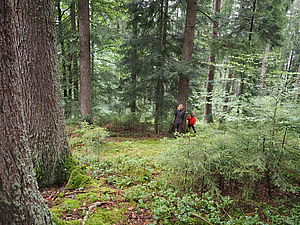
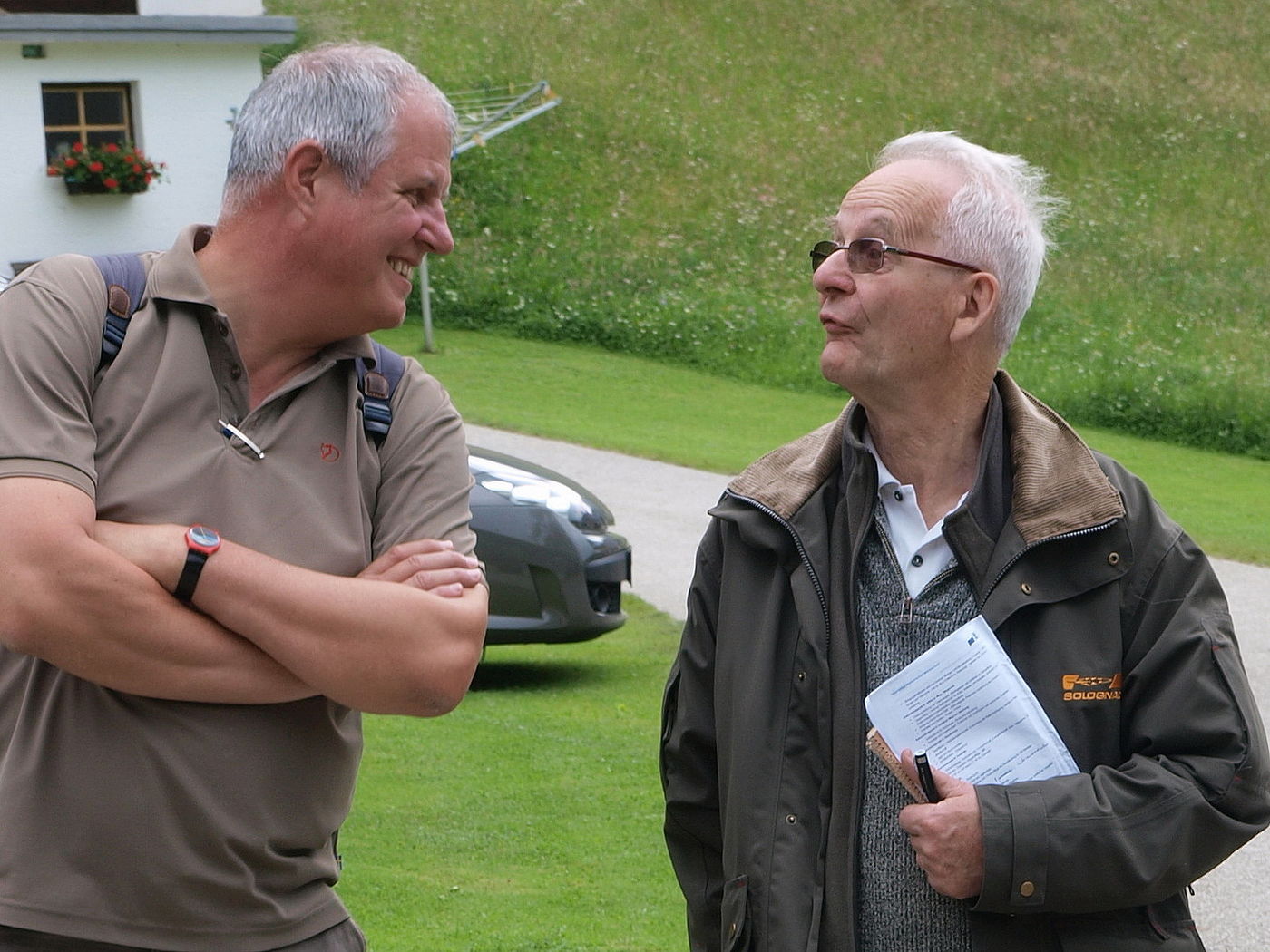
One big spruce was cut in a demonstration felling dedidated to President Jean Ph. Schütz
Under the chairmanship of Univ. Prof. J. Ph. Schütz from Switzerland, the 37 delegates from the 25 European member states met for their annual meeting in Ossiach to discuss the problems at hand. Although there are large regions with similar problems, e.g. Central Europe, there are also large regional differences. The forests of the member countries range from Norway to Portugal and the Balkans. The whole Mediterranean region has different conditions, with large destroyed forests, agricultural use (cattle grazing in the forest), settlement pressure, fragmentation, fire destroying large areas of forest every year. On the other hand, in densely populated parts (Holland) the demands on the forest are shifting, only a few people live from wood use, more are already interested in nature conservation, but many want to relax in the forest. The multifunctionality of forests is increasingly in demand, but climate change, carbon storage, stability and nature conservation need solutions.
Brussels cannot issue Europe-wide valid forest and forestry regulations; national interests are too different. But many potent groups are lobbying there, often for money, to promote group interests. The small group of Pro Silva's group only has a chance to be heard if it does a good job. The discussion has shown that Austria is very well informed about the conditions and mechanisms of forestry there with Dr. Georg Frank.
More than 40 delegates from 25 European countries met between 16th and 18th June in the forest training center in Ossiach and had three day of field excursions in neighbouring province of Styria and nearby in forests in Carinthia. The contrasted program lead to forest estates as well as to forest farms and had a beautiful ambiente at the Lake of Ossiach.
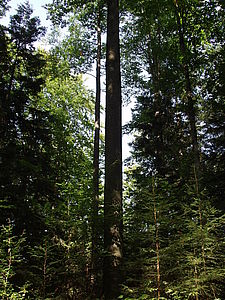
In addition to the annual delegates' conference at the Ossiach Forestry Training Centre, the participants will be given an insight into Austrian near-natural forest management. Most of the excursions will take place in Carinthia, with a focus on the successful Leader+ project Sustainable Forest Management Central Carinthia. In addition to the Poitschach forest enterprise of the project leader Dr. Senitza, the Wachernig and Rinner forest farms, which were awarded the Austrian State Prize for exemplary forest management, will present nature-oriented forest management at the highest level of forestry expertise.
PRO SILVA EUROPA was founded in 1989. Austria has played a leading role from the very beginning. The Austrian branch PRO SILA AUSTRIA is an autonomous and independent association and currently has about 400 active members (2011). Half of them are rural forest owners, the other half are foresters and forest academics from all areas of forestry (small and large private forest enterprises, authorities, university, schools and others more). What they all have in common is that they manage their forests according to Pro Silva principles or teach the principles of close-to-nature forest management in the consulting and training sector.
Members of PRO SILVA AUSTRIA practise near-natural, sustainable forest management. Comprehensive sustainability according to Pro Silva's principles means not using the forest at the expense and against the needs of future generations. We understand forest management as comprehensive care and use of the forest. Management aims to ensure both ecological and socio-economic sustainability for forest owners and society in the long term.
At the conference, we want to convey to our European visitors and show that sustainable, near-natural forest management is possible in all sizes of forest enterprises and is practised in Carinthia, even in small rural forests and in extremely steep terrain!
Georg Frank, president Pro Silva Austria 2011

by Roman Schmiedler (Treasurer Pro Silva Austria)
From 15th to 18th June, Pro Silva Europa held its annual meeting of 2011 in Carinthia with delegates from 25 European countries and informed itself about nature-oriented, sustainable forest management in Central Carinthia and about the long-term conversion of old-growth spruce forests into site-appropriate permanent forests at the Maltese Forest Enterprise in Ligist and the forest estate “Gut Poitschach” near Feldkirchen, owned by family Senitza.
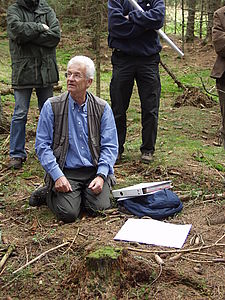
The Maltese forest enterprise, which has grown over centuries, today owns over 3.000 hectares of forest. As in most forestry operations, clear cutting dominated in the past. Up to 70.000 plants were afforested per year, today there are not even 2.000 - and the main mixed tree species.
Since the later Professor of Silviculture Dr. Josef Spörk took over the management of the company from his father in 1975, clear-cutting has been stopped, the stands are almost exclusively naturally rejuvenated, fir and beech are increasing again, but the proportion of the light tree species larch is declining. The professor emeritus has been asked several times about the decline of this well-paid tree species, he sees an increase in the proportion of larch as being associated with higher costs and would not correspond to the natural forest community, in contrast to the case of disturbed areas. He also sees increased risks in the cultivation of foreign tree species and therefore this is not pursued in the company. Apart from the promotion of mixed tree species, no young growth and thickening care is carried out, the natural elimination process is controlled with the light conditions during use. The numerous remaining stands of pole wood are prepared for the target diameter utilization by means of structural thinning. The uses are consistently marked by the foresters staff but are carried out by entrepreneurs. Essential for the utilization are the achievement of the target diameter under consideration of the quality, the function of the tree or group of trees with regard to the stability of the stands, not insignificant is the demand of certain assortments on the market (market adjustment). During an intervention, about 40 fm per hectare are taken and in about 7 years the trees return to the area with the utilization. The felled logs are pulled to the skidding trails with cable winches. In addition to a good equipment with truck roads (56 running m/ha) there are also approx. 150 running m/ha of skidding trails with a distance of approx. 50 m. This dense net allows a largely damage-free use if the work is done carefully. Mechanization of the single trunk use is not a problem with trunk by trunk display and appropriate control. It is essential that forest workers in silviculture are trained to understand the requirements. It only gets bad if the machinist is engaged in forestry, says Prof. Schütz. - This is not at all a rare condition in Austria.
The increment in the forest enterprise is still increasing, as is the stock, which is about 400 cbm/ha. The upper limit should be reached at 450 cbm/ha. Nature conservation is integrated into forestry, dead wood is taken care of and old trees are left standing specifically for biodiversity.

On the second day the delegates from Pro Silva Europe visited the Senitza forest enterprise in Poitschach. Dr. Eckart Senitza owns and manages around 840 ha of forest in the district of Feldkirchen, as well as 50 ha of agriculture land, meadows and a lake. He also runs a timber transport company, rents industrial properties and apartments, sells electricity from two hydro power plants, and maintains a forestry consulting office. - Although in the past branches were already closed down - sawmill and cardboard factory - the company still has several mainstays. 80% of the felling is done by the 4 company employees, only the use on steep slopes with cable crane installation and harvester thinning is outsourced to entrepreneurs. Originally, large fellings and agricultural areas were afforested with spruce. These stands were largely single layer and relatively vulnerable. In recent decades, random felling accounted for one third of felling, more than 20% was storm damage, the rest was bark beetle and snow breakage. Senitza has completely converted its operation to natural regeneration and target diameter selection cuttings. The employed forester marks the trees for cutting, taking the market situation into account. Due to the own workforce and the excellent infrastructure with forest roads and skidding trails, work can be done gently, and special customer wishes can be fulfilled quickly and easily. The company's own truck increases this flexibility even more.
Mainly natural regeneration saves more than 5,- €/ m³. The harvesting of large trees and the workflow reduces the harvesting cost in optimum down to 15,-€ / m³ for felling and transport to the forest roads. So this shown the high economic impact of this pathway in forest management, with an improvement of the profit contribution of up to 10-30 € /m³.
In forest inventory the Austrian "Prognaus" forest growth model is used, which is independent of yield table and tree distance. It can be used for yield and increment estimation under different harvesting regimes, so that an iterative theoretical approach for the sustainable harvesting regime can be made. In this respect more cooperation is expected from the scientific community, but there is no doubt that the results are valuable, especially for education. - Eckart Senitza has a lot of statistical material, he has compiled his figures in a comprehensive excursion guide in English language.

In 2004, 16 forest owners, who together own a forest area of around 1,100 ha, joined to form a consortium for sustainable forest management. This unique Leader Forest Project in Austria was co-financed by the EU, the Federal Government, and the Province. In this context, 50 action plots and 16 permanent observation plots were established, and a forest management plan was drawn up for each farm in cooperation, excursions and workshops were organised and, among other things, public relations work was carried out. Project manager was Dr Eckart Senitza.

The forest areas of these farms range from about 700 m to 1,600 m above sea level, the terrain is mostly steep with a high proportion of terrain for cable crane. Both farms have been awarded the State Prize for Exemplary Forestry, they have their own hunting area and are well equipped with forest areas and they also keep accurate records.
Until the 19th century timber for charcoal was harvested in the Metnitz valley and the forests were grazed until after the 2nd World War, which favoured the larch. Due to the storm damage, the larch finds a suitable germ bed and this ensures a higher proportion. Helmut Wachernig, chairman of the ARGE NACHWALTIGE WALDWIRTSCHAFT - consortium for sustainable forest management-, has been managing his well-stocked forest without any clear cut since 1990. A special feature is the extraction of larch resin, whereby the stronger larches are drilled into and the resin is extracted every 3 to 4 years.
The farm “Baar” of Dietmar Rinner is situated at 1.000 m above sea level, it was an auxiliary farm for almost 100 years. Resettlement, inheritance payments and a forest area purchase, as well as large storm damages have had a negative effect on the forest stand. As early as 1980, a switch was made from strip cuttings and “femel” cutting to single tree selection. A major reason for this change was the preservation of the site adapted genetics of spruce and larch. Both Rinner and Wachernig are struggling with game problems - with browsing by roe and red deer, but also bark peeling by red deer. The single tree selection cuttings dependent on target diameter is also applied in the calble crane terrain. Dietmar Rinner has played a significant role in the development of the small cable facility "Savall". The rope system, which was purchased in a community, can be set up by 3 men in less than 1 hour and its use is worthwhile even with small amounts of wood.
Both farms are involved in the local heating supply systems operated by farmers in St. Salvator.
The excursion participants were impressed by the expertise of the ARGE members, their commitment, and the implementation in practice. The functioning joint sale of timber has left a lasting impression.